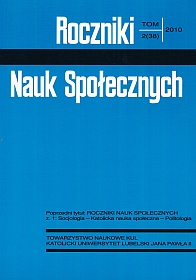Procesy megaurbanizacyjne w świecie
Abstrakt
The article is devoted to statistical analysis and assessment of urbanization processes. It is stressed that transformations of this kind are fairly complex and do not result only from the changes of relations between urban and rural population. They consist in complex economicalsocial phenomena that are reflected, among others, in formation of large urban complexes whose internal structure is ever more complicated. Their characteristic feature is spatial expansion. In the place where formerly only towns were, new, territorially extensive agglomerations and metropolises come into being. Because of a strong demographic dynamics resulting from the intensive development and technological progress, great urban complexes, numbering over 10 million inhabitants have appeared. The name of mega-agglomeration has been accepted for these new forms of urbanization. They have been defined and discussed on the basis of UN documentation. Attention has been paid to the fact that they develop most quickly in poor Third World countries. This has important social consequences. In the next part of the article the most modern and complex forms of nowadays urbanization have been discussed. In the areas with a lot of agglomerations new forms of big-city settlement are formed that are called “megalopolis”. They are listed and subjected to a proper geographical interpretation. They number several dozen million inhabitants each and their significance in the world is ever greater. A considerable part of the article is concerned with the so-called world or global cities. They are cities that perform the functions of the highest rank, mainly as far as the international finances are concerned. They are the seats of great corporations and concerns, banks and influential political and economic organizations. Studies conducted by a team of experts affiliated to the British University of Loughborough that has assumed the name “Globalization World Cities Study. Group GAWC” have been used here. On the basis of strictly defined criteria the team has distinguished 55 global cities. They have been divided into ranks and categories. London, New York, Paris and Tokyo have been included in the first rank. Also the rank of Warsaw has been defined; it has been given gamma rank and category 5. The classification is subjected to assessment. In the next part of the text the inner structure of the mentioned greatest global (world) cities is given and characterized. In the last part of the article it is indicated that the processes of mega-urbanization have a tendency to spread into new areas and continents. Disproportions between the areas of great concentration of population on the one hand and regions of demographic and economic regress on the other will increase. The most important consequences will occur in Asian, African and South American countries. In these parts of the world the processes of mega-urbanization will occur in a spontaneous way and may lead to an economic, social and ecological disaster.
Copyright (c) 2010 Roczniki Nauk Społecznych

Utwór dostępny jest na licencji Creative Commons Uznanie autorstwa – Użycie niekomercyjne – Bez utworów zależnych 4.0 Międzynarodowe.


